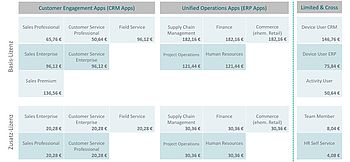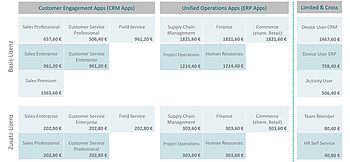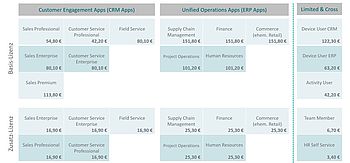New Commerce Experience (NCE) - new pricing and license model from Microsoft
Share:
Microsoft is currently changing the payment platform in the backend for all customers of business solutions on the Dynamics 365 platform (Finance, Supply Chain Management, Sales, Business Central, etc.). They are switching from legacy CSP to the new payment platform NCE (New Commerce Experience). This will also change the prices and license conditions for customers.
Even though both platforms will continue to run in parallel for some time to come:
- New subscriptions will only be available via NCE by March 10, 2022 at the latest.
- Renewals of existing subscriptions are possible until June 30, 2022 at the latest. From 1 July 2022, new licenses must be renewed in NCE.
What is the main innovation at NCE?
The main innovation in licensing via NCE is the question of the duration of the subscription. This is an important decision criterion that customers and partners should consider. This is because the choice of duration influences the price and flexibility in handling the licenses.
You can choose from
- Subscriptions with a term of one month
- Subscriptions with a term of one year
- Subscriptions with a term of three years
With the latter two options (1 year and 3 years), customers not only enjoy full price security over the selected period, but the license costs themselves are also 20% cheaper with these options than with the one-month term. This means that customers who commit to a longer period save money and are guaranteed the lower price for this period. Customers who choose the one-year term, for example, can also pay the license costs on a monthly basis.
However, this advantage also comes with a limitation. While the old model under Legacy CSP was still extremely flexible and the number of subscriptions could be adjusted upwards AND downwards at very short notice, this is no longer possible with NCE. New licenses can be added at any time, but no licenses can be cancelled before the subscription ends. If, for example, too many licenses have been booked or licenses are no longer required (e.g. because employees leave the company), they must continue to be paid for in NCE, even if they are not used. Licenses can of course be transferred to other employees at any time, but it is not possible to “freeze” licenses for a certain period of time (e.g. until a new employee requires this license) in NCE. Downward adjustments are therefore only possible at the end of the subscription term.
Price guarantee and planning security, in combination with a lower price: these are the plus points of NCE annual subscriptions. However, they come at the expense of flexibility.
| Duration: 1 month | Duration: 1 year | Duration: 3 years |
|---|---|---|
| The customer can change the number of licenses from month to month. Upwards and downwards. | The number of licenses can only be increased during the term, but not reduced. | The number of licenses can only be increased during the term, but not reduced. |
| Price is guaranteed for one month. | Price is guaranteed for one year. | Price is guaranteed for three years. |
| Monthly billing | Monthly or annual billing | Monthly, annual or triennial billing |
| Price: See overview below | Price: See overview below 20 % cheaper than with a monthly term | Price: See overview below 20% cheaper than with a monthly term. Correspond to the prices of the one-year term. |
What do licenses cost in NCE?
The following two tables provide a good overview of the prices and license costs.
- for full versions of the individual work areas (Sales, Finance, Commerce, etc.)
- for basic and additional licenses for the individual work areas
- for all other users with restricted or general rights
For a better understanding of the difference between base and attach licenses, when users need which license and what rights the limited and cross users have (device user, activity user, team member, etc.), we recommend this blog post: Pricing & Licensing of Microsoft Dynamics 365
Microsoft introduced the division of full versions into base and attach licenses almost exactly two and a half years ago. There was also a more extensive change to the then current pricing model on October 1, 2019, which we have described here: New pricing and license model - What's changing with Microsoft Dynamics 365 as of 01.10.2019
NCE: Prices for new customers - term 1 year (monthly billing)
Price comparison Legacy CSP and NCE
If you compare license costs in both price models (Legacy CSP vs. NCE) and only look at the costs per month or calculate down to the monthly costs, you will see that in the Legacy CSP (whether as a monthly subscription or as an annual subscription) licenses always cost exactly the same. These prices correspond to the price of the NCE annual subscription - also based on monthly billing. Customers who wish to avoid a price increase should therefore either remain in the Legacy CSP or take out an annual subscription via NCE
As mentioned at the beginning, there are two important deadlines that customers should keep an eye on.
June 30, 2022
Subscriptions that are due to expire on June 30, 2022 can either be extended in the Legacy CSP or transferred to the NCE by this date. You can also extend licenses that you are already using in D365 in the Legacy CSP until 30 June 2022. These will then be valid for as long as your current Legacy CSP subscription runs.
Example 1:
- If a one-year subscription to Legacy CSP expires on June 30, 2022 at the latest, you can extend this one-year subscription in Legacy CSP by one year - or switch to any model in NCE.
- What you cannot do is turn the one-year subscription in Legacy CSP into a three-year or monthly subscription in Legacy CSP.
Example 2:
- You have licensed Finance & Supply Chain Management and have the user types Full User, Activity User and Team Member. In this case, you can add any number of these licenses (e.g. X number of Activity Users for D365 Finance and Y number of Full Users for D365 Supply Chain Management) via Legacy CSP before 30 June. The duration of these subscriptions then corresponds to the duration of your current CSP subscription. After June 30, you must add new licenses via NCE.
- However, you will not be able to license a device user license for Finance or a full user for D365 Sales via Legacy CSP before 30 June 2022, for example. Because - as described in example 2 - you currently have neither device users for Finance nor full users for Sales, these would be new subscriptions for which the cut-off date of March 10 applies.
March 10, 2022
Until that day, customers can book, rebook, reduce, increase and extend whatever they want in the Legacy CSP: Regardless of whether you already have the workspace or user type or not.
Example:
- You have licensed Finance & Supply Chain Management and have the user types Full User, Activity User and Team Member. Then you have until March 10 to license a device user license for Finance and a full user for D365 Sales via Legacy CSP.
- And if you did this before March 10, you can still increase the number of licenses mentioned above as you wish until June 30 - even in Legacy CSP.
As you can see, there are still ways and loopholes to stay a little longer on the legacy CSP billing platform.
Can Legacy CSP and NCE be combined?
Yes, this is possible and in many cases it is also a very practical option.
Customers who still have their subscription (e.g. for Finance and Supply Chain Management) on Legacy CSP - and want to keep it - can only license new workspaces via NCE after 10 March. In this example, the “ERP licenses” would then run on Legacy CSP and the “CRM licenses” via NCE.
In addition to a combination of Legacy CSP and NCE, it is also possible to combine several different NCE subscriptions. We recommend this, for example, to customers who need a higher number of CRM licenses for certain time windows (e.g. for their Christmas business) at short notice - i.e. limited to 1 or 2 months. In this case, the fixed number of CRM licenses for the core workforce could be covered by the low-cost annual subscription in the NCE and the additional licenses by the slightly more expensive monthly NCE subscription. Although you would then have two NCE subscriptions running in parallel in the short term, you could save a lot of money and remain flexible at the same time.
Legacy CSP or NCE?
Whether users of the D365 platform should try to stay on Legacy CSP a little longer and use a few of the existing backdoors to do so, or whether it can make sense to switch to NCE early (or to reject the options to stay on Legacy CSP for longer) is a case-by-case consideration that we are currently examining with all our customers. Depending on the result, we sometimes do one, sometimes the other and occasionally we also combine both models.
Further information
Do you use the D365 platform and are still undecided whether you should switch to NCE - or delay the switch a little longer? Then write to us directly using the contact form at the end of this blog post. We will be happy to get in touch with you.







